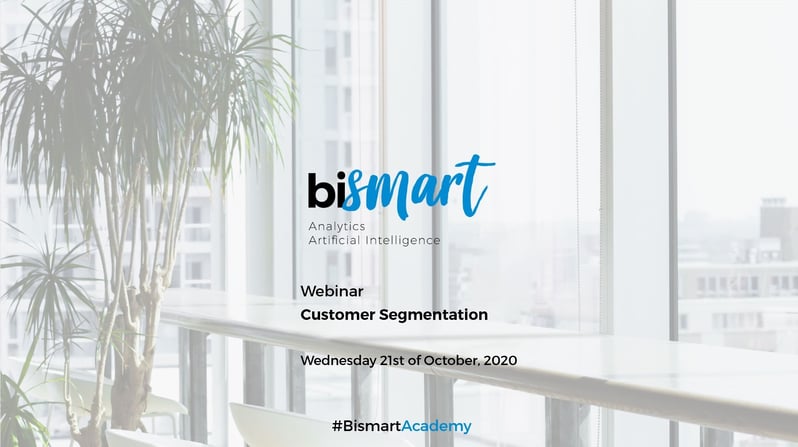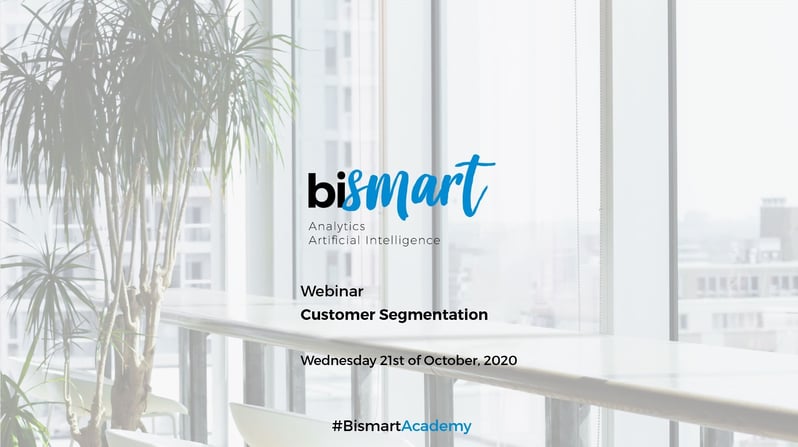On the 21st of October we made a webinar about Customer Segmentation during which we explained how to use the concept with our tool.
Last Wednesday, October 21, our Head of Data Strategy & Insights Borja Martín held the Customer Segmentation webinar during which he explained the concept and showed a practical example of its use through the Bismart Customer Segmentation tool.

If you were not able to attend or want to watch the broadcast again, you can watch the full video below.
You can also read a summary of the session:
Segmentation is a central axis within the customer strategy. The segmentation of customers allows us to know which are the value groups that govern the interest and focus our action and which ones we should address. It is a step that follows the definition of the buyer persona and the market analysis and definition and precedes the positioning of the solution and the go-to-market strategies.
According to Borja, customer segmentation must be addressed as strategically as possible, through a view that leads us to connect better with our audience. The purpose of segmentation should be to help us connect with the audience, understand it better and gain conversion.
What does segmenting mean?
Essentially, to segment is to classify our market once it has been defined and to structure it into parts or groups. Segmenting leads to getting to know each one of our clients better. When it comes to decision making, and especially in the digital era, segmentation allows us to differentiate ourselves when we make our own decisions about our client portfolio and we don't just use Google or Amazon segmentations, for example.
What is it for?
To establish priorities and decide where to focus my efforts and to better define actions towards the market in order to know which ones will leverage me towards the segment I am interested in. It also brings us closer to the client and we can listen to him more, get better feedback and place him at the center of our strategy. In addition, we can optimize customer experience, which allows us to differentiate ourselves from the competition and identify new business opportunities. We will be able to see what points we may not be covering well, what is relevant now thaat was not before, and detect pain points.
How has it evolved?
Some time ago when we segmented, we had 2 main variables: sociodemographic data and device use or geographic data. Now we add behavioral data, transactional data, marketing automation, channel use, situational data, navigation pattern data, customer journey data, customer service relationship data... We can no longer limit ourselves to considering a single customer profile thinking that we understand them by knowing their gender, age and where they live. Now we must understand that the customer changes and evolves, that they have different needs according to the moment or that through their own experience in relation to our product or service we can see nuances of his behavior that are interesting. The customar has many faces and it is important to understand them and integrate them within the segmentation models so that they turn into better offers, better listening, better adaptation to the language they use... in short, differentiation.
How do we use the data to segment?
The main premises to take into account from a data point of view are:
- Analyze the available information
- Integrating information
- Make it operational
- Completing or enriching it
What is the model we work with at Bismart?
There are many ways to segment. We use advanced segmentation that pivots on a transactional model and a rich cluster model based on RFM (Recency, Frequency, Monetary).
How does it work?
The model works in Microsoft Power BI. It has several areas in which different analyses are carried out.
During this part of the session, Borja showed the various screens of the model. First, he demonstrated the analysis based on the ABC customers analysis. This is one of the simplest, most descriptive, and most business-driven ways of performing this analysis.
The model can be segmented by RFM. RFM stands for Recency, Frequency and Monetary. Recency is the last time the customer was related to my brand. In the example of hotels used by Borja, it refers to the last time the customer was in one of my hotels. Frequency refers, as the name suggests, to how often the customer consumes my brand. In the case of the demo it is the number of nights spent in the hotel. Monetary is the amount of money spent by the customer.
If there is not much recency, it means that there are no clients who come regularly, so we may be talking about a vacation type hotel. A city hotel that is more oriented towards business workers would have a higher recency, since customers usually stay at the hotel for work, for example. If we analyze it from Monetary's point of view, we can see a chart that shows how customers are distributed by season or by spending range and visualize a detailed analysis according to customer type and spending range, as well as how many stays there have been in a concrete time period.
As Borja showed, in the analysis you can define high or low season, customer nationality, segment frequency, etc.
From the RFM, we can make a comparative analysis. For example, you can compare the recency of the high and low season in a concrete time period or add criteria of season, date, channels, a particular hotel, etc.
The next screen is Customer Types Matrix and it consists of a matrix with two main variables that we have already seen: recency and frequency. From here we select customers according to their behavior based on these two variables and we can see the characteristics of each segment. Then, we can see a chart of the characteristics of each segment. We have classified them into clusters: leisure, sport, business, events, gastronomy, etc. With this information we should make informed decisions, such as, in this example, reactivate sleeping customers or encourage regular ones.
In the Market Segment Matrix screen we see how the clusters behave. It is an inverse analysis to the previous one. Within each cluster, we can see what types of customers there are.
The Reservation Clusters analysis shows, from the point of view of reservations, how many are made in advance and how many days that advance is made with. In addition, we can compare them according to the date of the reservation or the nationality of the clients.
Next, Borja showed the screen Clusters of stays, in which we see the average number of clients per stay, how much each type of client consumes in the hotel, how they distribute their stay (double rooms, type of accommodation, etc.) and the evolution of the expense through time.
Finally, we arrive at KPIs, which are metrics added to the analysis, such as how many clients are new, how many we have lost, what marketing expenses we have, the cost of acquisition of each client, average cost of acquisition, churn, etc., all compared to the previous period we determine. We can also know how this information evolves. All the graphics of this model are navigable and we can choose multiple criteria to visualize them.
